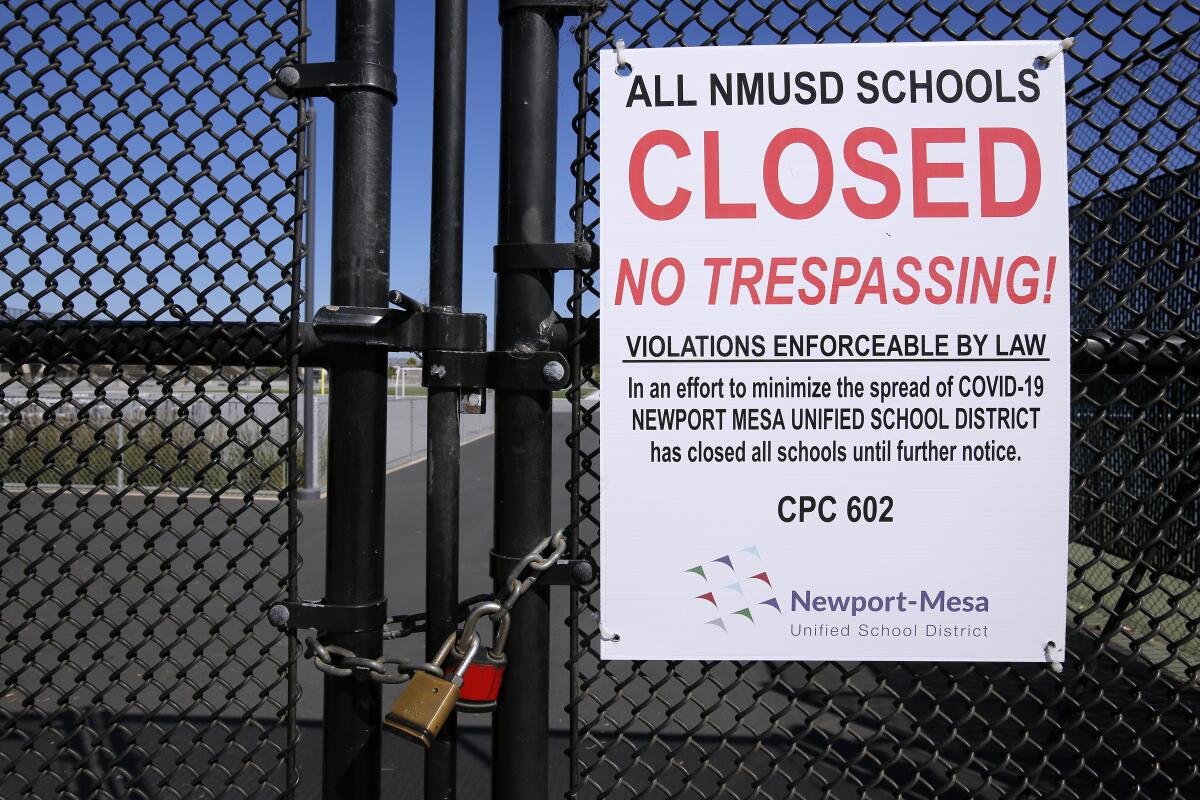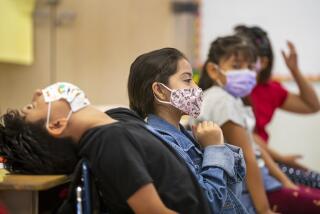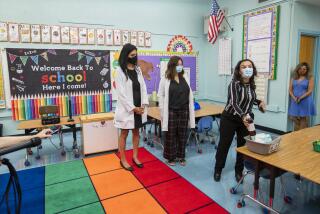Editorial: Kids are hurting. Reopen California schools as soon as COVID rates drop

- Share via
This isn’t the moment for a massive reopening of schools in California. Not with COVID-19 levels as bad as they are and getting worse. But it is time to start planning for reopening classrooms as soon as hospitalization and infection rates drop again. President-elect Joe Biden wants to help most of the country’s schools reopen by April 30, but that’s not ambitious enough. By that point, nearly a whole academic year would be lost.
In the earlier days of the pandemic, the reluctance to open schools made sense. What epidemiologists didn’t know about the new coronavirus far outstripped what they knew. Teachers were justifiably nervous — and working harder than ever to engage students in learning despite the challenges of video conferencing. Surely classrooms full of runny-nosed children, notoriously lax about the fine points of personal hygiene, would be superspreading event waiting to happen.
In this case, however, what seemed intuitively obvious hasn’t worked out that way. Though colleges, where authorities have less control over student behavior, have been plagued with major outbreaks, schools for younger students have not. That’s especially true of elementary schools, where children appear to be far less likely to be sickened or to transmit the virus. Teachers and other school workers don’t appear to have been catching the virus at school any more frequently than they would have in the community — although the infection rate has been higher for them than for students. Safety measures such as masks, hand-washing and better ventilation and air filtration make a crucial difference.
So the predisposition to not reopen schools needs to change, even while cases and hospitalizations are rising. No longer should the foremost questions be, “Why should we do this, and when will it be completely safe?” Instead, they should be, “Why not reopen, and what’s the best way to reduce risk?” Waiting for vaccines to be widely available isn’t a good option because it would sacrifice a significant chunk of the school year.
Schools in Europe were mostly kept open despite infection rates that were rising this fall. The findings: Schools weren’t a significant factor in infections. A new study published in the medical journal Lancet found that the reopening of schools in England during the summer was associated with few cases. One important caveat: The study found that higher community transmission meant higher numbers of cases in schools.
That’s the “why not?” in the equation; California must take the health of communities into account before reopening schools. But that doesn’t necessarily mean waiting until a county drops into the lowest tier of viral spread, especially for elementary grades. And once schools reopen safely, they should not close again unless outbreaks start increasing. Last week, Los Angeles Unified School District closed its successful program for 4,000 special-need students even though there was no indication of new cases among them or the staff.
New York Mayor Bill de Blasio opened schools in New York this fall, then temporarily closed them because the city’s infection rates had exceeded the 3% threshold that had been set in advance. But within days, he changed his mind and reopened them for elementary students. In fact, he doubled down: Before the halt, students were attending school part-time and studying remotely the rest of the time. Now many of them will be offered the opportunity to learn on campus five days a week, at least for as long as it proves safe.
The change of mind wasn’t caused by a new drop in infections. Instead, parents had blasted the mayor for the decision to go all-remote again, becoming as loud and powerful a voice as the teachers union had been for keeping the schools closed. Up until the closure, New York schools had opened only partially but safely. There was no inherent magic to the 3% positivity rate; schools in other places had reopened successfully with significantly higher rates. Up until this point, the concerns of the teachers union have been the single biggest factor in whether or not to keep schools open, but they were losing popular support as parents rose up to say they wanted their kids on campus.
Other essential workers have been at their posts for months now. Why shouldn’t teachers and other school staff be seen as essential, too?
That question has become more urgent as the story of remote learning has unfolded. Yes, online lessons have improved tremendously since the start of the pandemic, involving more face-to-face time between students and teachers. Most students now have computers and broadband, and teachers themselves have learned to provide more effective online lessons. Attendance is taken, at least to some extent, and grades are given.
But “better than last spring” is a depressingly low bar. In L.A. Unified, being counted as attending could mean simply handing in an assignment or spending a few minutes in a Zoom class before logging out for the rest of the day. Grades have dropped precipitously, here and in other school districts. This is not even close to an on-campus experience, especially for low-income students and those with language barriers or other particular needs.
Some educators have suggested leaving the entire cohort behind a grade to repeat next year. But that would be a boring and wasted year for students who managed to stay up to grade level. Promoting some and not others would mean widening the gap between low-income students and more affluent ones.
School is the main delivery system for food and social services to impoverished students. Though L.A. Unified continues to provide that food, many students nationwide go without. And all students lose out on counseling; they’re socially isolated and lonely, and the youngest ones are missing developmental milestones. Parents have been forced to leave work in order to be home for them, another stress on families.
An October report by the Century Foundation and Center for American Progress estimated that millions of mothers would lose their jobs because they had to stay home with their children, a responsibility that falls to women far more than men in our society. This would mean a loss of billions of dollars for the economy, the report said, and set women back in the workplace by a generation.
Multiple factors have held our schools back while schools in Europe have reopened successfully. They must be addressed lest U.S. students fall further behind on the global curve and suffer consequences in social and emotional development.
- Robust testing and tracing must be in place. L.A. Unified already has that ready to go. Many other schools don’t. Pooled laboratory testing, in which samples from multiple students are tested at once, could help. Rapid antigen testing — faster and much cheaper than traditional laboratory tests — might also prove effective.
- Reopening is expensive, partly because of the need for testing and protective equipment, but even more because of the need for extra personnel. Every time teachers or other staff members are exposed to the virus, even if they haven’t been infected, quarantining is necessary, which means substitutes must be found and paid. A wave of new relief for schools is needed.
- In general, officials rely too much on “positivity rates” — what percent of tested people prove to be infected — rather than putting more emphasis on hospitalization rates. In areas where more people are tested, positivity rates will generally come out lower, but don’t necessarily reflect a lower incidence of disease. Hospitalization rates are a better, though still imperfect, indicator of the prevalence of the disease and its impact on the community. Right now, those rates are too high in much of California to allow extensive reopening, but once hospitalizations fall, positivity rates should not be the factor that can single-handedly keep students off campus.
- Teachers unions have been the most powerful political force preventing reopenings. While their concerns have been understandable, they are largely not based on the reality in schools. Reopening must be based on the data and science rather than on the concerns of the most fearful group.
- More centralized decision-making is needed. School districts are often hamstrung when unions are adamant, which is why a statewide approach geared toward reopening would be more effective. (In Europe, there is far more federal control over schools.) Gov. Gavin Newsom has set limits on when schools can reopen, but no mandates for when they must.
Assemblyman Phil Ting (D-San Francisco) introduced legislation last week that would require schools to reopen when counties drop out of the tier with the worst infection rates — which right now covers most of the state’s population. The measure would help — if the funding comes with it to make reopening a possibility. There also should be more leeway on when elementary schools open than when high schools do, since teenagers appear more apt to spread the disease. And at lower COVID levels even within the highest-risk tier, there should be more pressure to open some classrooms.
School districts will certainly see some cases of infection, but it’s bars and home gatherings that cause disease surges, not schools. And keeping schools closed has its own dangers, not just to the kids whose learning is derailed, but also to the parents who must leave work to stay home with them. The economy suffers too. In fact, we’re all worse off.
More to Read
A cure for the common opinion
Get thought-provoking perspectives with our weekly newsletter.
You may occasionally receive promotional content from the Los Angeles Times.










